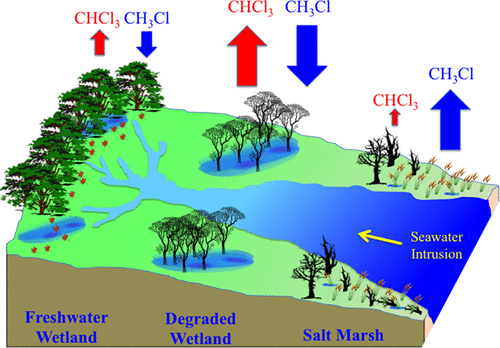当前位置:
X-MOL 学术
›
ACS Earth Space Chem.
›
论文详情
Our official English website, www.x-mol.net, welcomes your feedback! (Note: you will need to create a separate account there.)
Halocarbon Emissions from a Degraded Forested Wetland in Coastal South Carolina Impacted by Sea Level Rise
ACS Earth and Space Chemistry ( IF 3.4 ) Pub Date : 2018-08-02 00:00:00 , DOI: 10.1021/acsearthspacechem.8b00044 Yi Jiao 1 , Alexander Ruecker 2 , Malte Julian Deventer 1 , Alex T. Chow 2 , Robert C. Rhew 1
ACS Earth and Space Chemistry ( IF 3.4 ) Pub Date : 2018-08-02 00:00:00 , DOI: 10.1021/acsearthspacechem.8b00044 Yi Jiao 1 , Alexander Ruecker 2 , Malte Julian Deventer 1 , Alex T. Chow 2 , Robert C. Rhew 1
Affiliation

|
Tropical- and subtropical-storm surges combined with sea level rise cause saltwater intrusions into low-lying coastal ecosystems along the southeastern coast of the United States, gradually converting freshwater forested wetland into saltmarsh. The transition zone between freshwater and saltwater ecosystems becomes a degraded forested wetland, where the combination of high levels of soil organic matter and elevated concentrations of halide ions creates a dynamic biogeochemical environment that may be a potential hotspot for halocarbon formation such as chloroform, methyl chloride, and methyl bromide. This study conducted field measurements at a transition zone in coastal South Carolina to quantify halocarbon exchange rates and laboratory soil incubations to determine the contributions of biotic versus abiotic processes. The degraded forested wetland showed significant chloroform emission rates (146 ± 129 nmol m–2 d–1). The degraded forested wetland remained a net sink for methyl chloride and a negligible source/sink for methyl bromide, unlike the saltmarsh which was a significant source for both. The laboratory incubations strongly suggest that methyl halide consumption in soils at the field site was biotic and that production of methyl halides and chloroform was largely abiotic and temperature-dependent, although additional experiments are required to rule out possible biotic production involving heat-resistant microbes. The results suggest that sea level rise and more frequent storm surges derived from global climate change, in the long term, may increase emissions of chloroform from coastal degraded forested wetlands and of methyl halides if salt marshes expand, with potential impacts for stratospheric ozone depletion.
中文翻译:

受海平面上升影响的南卡罗来纳州沿海退化森林湿地的卤烃排放
热带和亚热带风暴潮加之海平面上升,导致盐水入侵了美国东南沿海的低洼沿海生态系统,从而逐渐将淡水林地湿地转变为盐沼。淡水和盐水生态系统之间的过渡区变成了退化的森林湿地,高水平的土壤有机物和高浓度的卤化物离子的结合创造了一个动态的生物地球化学环境,这可能是形成卤化碳的潜在热点,例如氯仿,氯甲烷和甲基溴。这项研究在南卡罗来纳州沿海地区的过渡带进行了实地测量,以量化卤代烃的交换速率和实验室土壤培养,以确定生物与非生物过程的贡献。–2 d –1)。与盐沼不同,退化的森林湿地仍然是甲基氯的净汇,而甲基溴的来源/汇却可以忽略不计,而盐沼是两者的重要来源。实验室的研究结果强烈表明,田间土壤中甲基卤的消耗是生物性的,卤代甲烷和氯仿的产生在很大程度上是非生物的且依赖温度,尽管还需要进行其他实验来排除可能产生的涉及耐热微生物的生物。结果表明,从长远来看,全球气候变化引起的海平面上升和更频繁的风暴潮可能增加沿海退化森林湿地的氯仿排放量,如果盐沼扩大,还会增加卤代甲烷的排放量,这可能对平流层臭氧消耗造成潜在影响。
更新日期:2018-08-02
中文翻译:

受海平面上升影响的南卡罗来纳州沿海退化森林湿地的卤烃排放
热带和亚热带风暴潮加之海平面上升,导致盐水入侵了美国东南沿海的低洼沿海生态系统,从而逐渐将淡水林地湿地转变为盐沼。淡水和盐水生态系统之间的过渡区变成了退化的森林湿地,高水平的土壤有机物和高浓度的卤化物离子的结合创造了一个动态的生物地球化学环境,这可能是形成卤化碳的潜在热点,例如氯仿,氯甲烷和甲基溴。这项研究在南卡罗来纳州沿海地区的过渡带进行了实地测量,以量化卤代烃的交换速率和实验室土壤培养,以确定生物与非生物过程的贡献。–2 d –1)。与盐沼不同,退化的森林湿地仍然是甲基氯的净汇,而甲基溴的来源/汇却可以忽略不计,而盐沼是两者的重要来源。实验室的研究结果强烈表明,田间土壤中甲基卤的消耗是生物性的,卤代甲烷和氯仿的产生在很大程度上是非生物的且依赖温度,尽管还需要进行其他实验来排除可能产生的涉及耐热微生物的生物。结果表明,从长远来看,全球气候变化引起的海平面上升和更频繁的风暴潮可能增加沿海退化森林湿地的氯仿排放量,如果盐沼扩大,还会增加卤代甲烷的排放量,这可能对平流层臭氧消耗造成潜在影响。


























 京公网安备 11010802027423号
京公网安备 11010802027423号